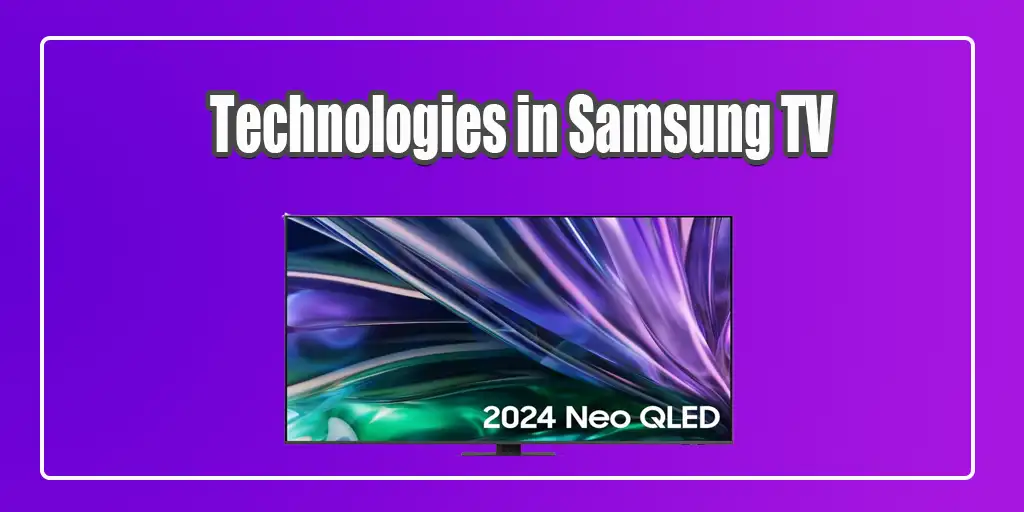Exploring Samsung TV technologies opens up a wide range of possibilities, making it laborious to learn about each one individually. This article provides a brief overview of the main technologies used in Samsung TVs, allowing buyers to get a clear understanding of their capabilities.
Technologies in Samsung TV, brief description
Image Technologies
- Active Crystal Color: Expands the color palette.
- Auto Motion Plus: Enhances the clarity of dynamic scenes by adding intermediate frames.
- Auto Depth Enhancer: Automatically adjusts contrast to create a depth effect.
- Contrast Enhancer: Algorithms to improve image contrast.
- Dynamic Crystal Color: Expands the color range.
- HDR (High Dynamic Range): Enhances contrast and brightness using metadata in the video.
- Micro Dimming: Local backlight adjustment for deeper blacks.
- Peak Illuminator: Balances brightness in dark and light areas for an improved overall image.
- Precision Black: Controls local dimming for richer black tones.
- PurColor: Enhances color purity and smooths pixel transitions.
- Ultra Black: Reduces screen glare with a special coating.
- Wide Color Enhancer: Enhances color representation on 8-bit screens.
- Supreme UHD Dimming: Local dimming technology to improve contrast.
- Picture-in-Picture: Allows two video streams to be displayed simultaneously.
- High Frame Rate (HFR): Supports smooth playback of high-frame-rate content.
- AI Image Quality Optimization: Uses AI to enhance image quality for better clarity and detail.
- AI Motion Enhancer: AI-driven technology that optimizes motion processing for smoother action.
- AI Auto Game Mode: Automatically adjusts settings for optimal gaming performance.
- Adaptive Picture: Dynamically adjusts picture settings based on viewing conditions.
- AI Saver Mode (market-dependent): Optimizes power usage while maintaining image quality.
- Real Depth Enhancer: Enhances depth perception through advanced image processing.
- Mini Map Zoom: In games – create a mini-map and display it on the screen.
- Motion Xcelerator: Motion index, with the enhancement programs enabled, how one sees the image compared to the real frame rate, the index is twice the real frame rate..
- OLED HDR: Optimizes HDR content for OLED displays.
- Pantone Validated: Ensures color accuracy according to Pantone standards.
- Pantone SkinTone Validated: Validates color accuracy for skin tones according to Pantone standards.
- Ultra Viewing Angle: A marketing term that doesn’t reflect any real benefits..
Audio Technologies
- Dolby Digital Plus: Supports audio decoding for 5.1 and 7.1 formats.
- DTS Codec: Competing audio format developed by DTS.
- Bluetooth Audio: Allows connection of wireless headphones.
- Multiroom Link: Enables connection of wireless speakers to the TV.
- Audio Return Channel (ARC): Sends audio from the TV back to a compatible sound system via HDMI.
- Enhanced Audio Return Channel (eARC) on HDMI 2.1: Improved version of ARC, supporting higher-quality audio formats.
- Object Tracking Sound (OTS): This audio technology adjusts the sound based on the movement of objects on the screen, providing a more immersive audio experience.
HDMI and Connectivity
- Anynet+ (HDMI-CEC): Controls HDMI-connected devices using the TV remote.
- HDMI Quick Switch (InstaPort): Enables fast switching between HDMI ports.
- Mobile to TV, Mirroring: Displays the screen of a mobile device on the TV.
- TV to Mobile, Mirroring: Streams the TV screen to a mobile device.
- ConnectShare™: Plays media files from USB devices.
- UHD Upscaling: Upscales content to UHD resolution.
- High-bandwidth Digital Content Protection (HDCP) 2.3: Ensures compatibility with protected digital content.
- Auto Low Latency Mode (ALLM): Automatically switches to low latency mode for gaming.
- Variable Refresh Rate (VRR): The TV has a floating frame rate that adjusts to the game console.
- One Connect Box port: The TV has an external unit with the main boards and ports.
Voice and Smart Features
- Alexa: Integration with Amazon Alexa for voice control.
- Bixby: Samsung’s native voice assistant.
- Google Assistant: Integration with Google Assistant for voice control.
- Far-Field Voice Interaction: Enables voice control from a distance. The TV has a built-in microphone.
- Voice Interaction (Voice command): Voice recognition via the built-in microphone in the remote control.
- SmartThings: Samsung’s platform for smart home control.
- Samsung TV Plus: Free streaming service with live channels and on-demand content.
- Samsung Gaming Hub: A platform for discovering and playing games on your TV.
- Samsung Health: Health and fitness app for tracking activity.
- Samsung Daily+: Personalized news, entertainment, and content service.
- Samsung Knox: Samsung’s security solution to protect your device and data.
Additional Features
- Accessibility (TalkBack / Improved Visibility / Assisted Hearing / Remote Control Adjustment): Features designed to improve accessibility for users with disabilities.
- Ambient Mode+: Turns the TV into a decorative display when not in use.
- Brightness and Hue Sensor: Adjusts the brightness and color to match the lighting conditions.
- EyeComfort Mode: Optimizes screen brightness and color for eye comfort.
- Filmmaker Mode: Provides the most accurate picture settings for watching movies, video without any software enhancements.
- Game Motion Plus: Enhances gaming visuals by improving motion clarity.
- HDR Brightness Optimization: Adjusts brightness for optimal HDR performance.
- HDR Gaming Interest Group (HGiG): Optimizes HDR for gaming content.
- Hue Sync (Lighting sold separately): Syncs TV visuals with external lighting for an immersive experience.
- Camera: Built-in camera for video calls or other uses (in some models).
- Network: Supports network technologies for data exchange with other devices.
- Connectivity: Available connectivity ports, slots, and interfaces for external devices.
- MagicScreen+ Matter: Uses AI to adapt the TV display to match content type.
- Tap View: allows you to broadcast the image from the screen by bringing your mobile device to the remote control, which has a built-in NFC module.
- Super Ultrawide GameView & Game Bar: Customizes screen settings for ultrawide gaming experiences.






